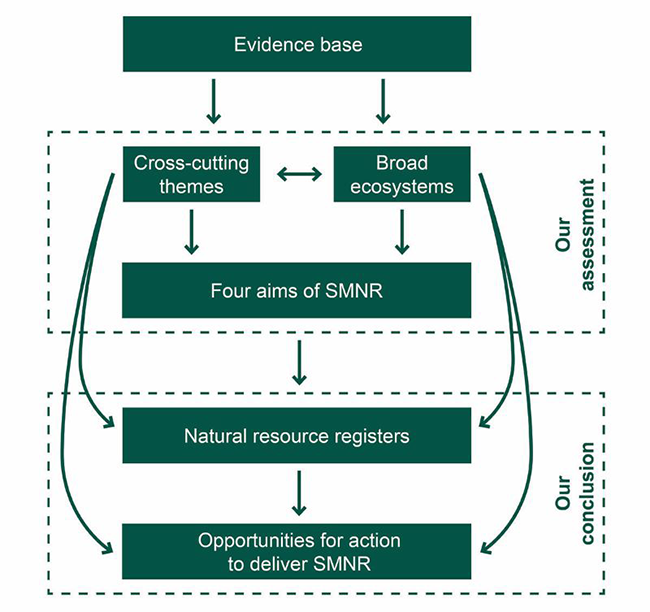SoNaRR2020: Our method
The SoNaRR interim report in December 2019 set out the method we have used to assess Wales’s achievement of SMNR. In SoNaRR2020 we applied it through the twin lenses of ecosystems and cross-cutting themes.
The starting point for SoNaRR2020 was the completion of the technical chapters which set out the available information and evidence about the achievement of SMNR relating to both broad ecosystems and cross-cutting themes.
Each chapter documents the drivers, pressures and impacts which are barriers to the achievement of SMNR and recommends opportunities for action to manage them.
That evidence has been carried forward to the natural resource registers and used to make the assessments against the four aims of SMNR with the addition of wider available evidence such as international reports and publications.
The flow of evidence through SoNaRR2020 is shown in the figure below.

Figure 1 - Figure showing how evidence has been used in the SoNaRR2020 assessments as described in the text
As in SoNaRR2016, the evidence in SoNaRR2020 continues to follow the internationally recognised DPSIR approach of driver of change, pressure, state, impact and response.
SoNaRR builds on DPSIR and uses that structure to assess progress towards SMNR and the Welsh well-being goals.
The five step approach taken within SoNaRR is set out below.
It shows how each element of DPSIR is addressed in order to assess the four aims of SMNR.
Step 1: What’s needed - the scope of the report
Captures information on how Wales is moving towards sustainable management of natural resources; including identifying the drivers of change and what supports sustainable development.
Step 2: State and trends of natural resources and current management, within the broad ecosystems and cross-cutting themes
Identifies pressures and the state of natural resources and ecosystems - the most traditional step. Relevant to goals 1 and 2.
Step 3: Resilience: What is the impact of the state of natural resources and their management on the resilience of the ecosystem
An assessment of ecosystem resilience – using the attributes from the Environment (Wales) Act – alongside spatial modelling of ecological functions, resilience and ecosystem service supply and demand. Relevant to goal 2.
Step 4: Ecosystem services: What is the impact of the state of natural resources and their management on the supply of ecosystem services to people
An assessment of the links between ecosystem condition and well-being for people in Wales, and the state and condition of natural resources in relation to the derived benefits. This step is the key interface between ecological and socio-economic evidence. Relevant to goals 1, 3 and 4.
Step 5: Opportunities for action for more sustainable management
Using the Natural Capital Committee’s risk register approach to set out the evidence on the impacts of the issues identified and the benefits of taking various management options in response.
Collaborative working
SoNaRR is about Wales, not NRW, and we needed to ensure that a broad view of the subject is represented. We used national and theme-based workshops, consultations, reviews. There was direct communication with stakeholders in the development of the ecosystem and cross-cutting theme technical chapters to bring in evidence and represent their views.
We have followed our evidence review process throughout. All the ecosystem and cross-cutting theme technical chapters have been through an academic peer review process.
The natural resource registers have been reviewed via a stakeholder workshop and the assessments against the four aims have been reviewed by an external panel, comprised of members of the SoNaRR stakeholder group and including members of NRW’s new environment advisory committee.
